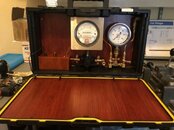If the cracking pressure is too high, then you have not adjusted it to optimum. If that is the best you can get out of it by adjusting, then something else of wrong. Could be a seat, orifice, spring, debris causing the lever to bind, the lever itself, striations on the diaphragm disc, etc.So, once you determine that the regulator cracking pressure is off a little, what second stage adjustments are possible assuming you have already adjusted the valve seat to optimum?
My understanding concerning a piston-type first stage is that if the IP is low you add shims, too high you remove shims, and if it creeps there is a leak in an o-ring or the valve seat. Anything else?
Wrong, bad, dirty, or double engraved hp soft seat or a defect on the hard seat. Insufficient lubrication of the piston stem and/or piston stem o-ring. The main spring rarely goes bad, but that can happen too.





